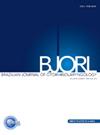局部晚期头颈部鳞状细胞癌的肿瘤干细胞生物标志物
IF 1.8
4区 医学
Q2 OTORHINOLARYNGOLOGY
引用次数: 0
摘要
目的分析局部晚期头颈部鳞状细胞癌(HNSCC)患者中肿瘤干细胞标志物的存在,并确定其作为常规临床样本中预后生物标志物的适用性。方法回顾性分析连续104例局部晚期鳞癌患者行明确手术加辅助放化疗的临床资料。在手术标本中评估CD44、hla - 1、泛细胞角蛋白和磷酸化表皮生长因子受体(p-EGFR)的免疫组织化学表达。根据临床特征和总阳性评分(肿瘤标志物表达)计算总生存率(OS)和无病生存率(DFS)。采用Cox多因素分析计算风险比。结果中位随访50个月后,无宫颈结病理累及患者(p < 0.001)、hla - 1过表达且总阳性评分≥15% (p = 0.017)、CD44低表达且总阳性评分≤60% (p = 0.022)的总生存率较高。p- egfr (p = 0.648)和泛细胞角蛋白(p = 0.477)表达分组在OS中的差异无统计学意义。没有生物标志物与不同的DFS率相关。Cox多因素分析显示,宫颈结阳性(HR = 1.294;95% ci 1.025-1.634;p = 0.030)和HLA表达量(HR = 0.373;95% ci 0.168-0.829;p = 0.015)和CD44 (HR = 2.170;95% ci 1.031-4.569;p = 0.041)与OS独立相关。结论淋巴结受累、hla - 1过表达和CD44表达降低是局部晚期HNSCC患者生存的独立预后因素。证据水平ii。本文章由计算机程序翻译,如有差异,请以英文原文为准。
Cancer stem cell biomarkers in locally advanced head and neck squamous cell carcinoma
Objectives
To analyze the presence of cancer stem cells markers in consecutive patients with locally advanced Head and Neck Squamous Cell Carcinoma (HNSCC) and establish their suitability as a prognostic biomarker in samples from routine practice.
Methods
Retrospective study of 104 consecutive patients with locally advanced HNSCC treated with definitive surgery and adjuvant chemoradiotherapy. Immunohistochemical expression of CD44, HLA-I, pan-cytokeratin, and phosphorylated Epidermal Growth Factor Receptor (p-EGFR) were evaluated in surgical specimens. Overall Survival (OS) and Disease-Free Survival (DFS) rates were calculated based on clinical characteristics and the total positive score (for tumor marker expression). Hazard ratios were calculated by Cox multivariate analysis.
Results
After a median follow-up of 50-months, higher OS rates were observed for patients without cervical node pathological involvement (p < 0.001), patients with HLA-I overexpression and a total positive score ≥ 15% (p = 0.017), and patients with low CD44 expression and a total positive score ≤ 60% (p = 0.022). Grouping by p-EGFR (p = 0.648) or pan-cytokeratin (p = 0.477) expression did not show statistical differences in OS. None of the biomarkers were associated with different DFS rates. Cox multivariate analysis revealed that positive cervical nodes (HR = 1.294; 95% CI 1.025–1.634; p = 0.030) and the expressions of HLA (HR = 0.373; 95% CI 0.168‒0.829; p = 0.015) and CD44 (HR = 2.170; 95% CI 1.031–4.569; p = 0.041) were independently associated with OS.
Conclusion
Nodal involvement, HLA-I overexpression, and decreased CD44 expression are independent prognostic factors of survival in patients with locally advanced HNSCC.
Level of evidence
III.
求助全文
通过发布文献求助,成功后即可免费获取论文全文。
去求助
来源期刊

Brazilian Journal of Otorhinolaryngology
OTORHINOLARYNGOLOGY-
CiteScore
3.00
自引率
0.00%
发文量
205
审稿时长
4-8 weeks
期刊介绍:
Brazilian Journal of Otorhinolaryngology publishes original contributions in otolaryngology and the associated areas (cranio-maxillo-facial surgery and phoniatrics). The aim of this journal is the national and international divulgation of the scientific production interesting to the otolaryngology, as well as the discussion, in editorials, of subjects of scientific, academic and professional relevance.
The Brazilian Journal of Otorhinolaryngology is born from the Revista Brasileira de Otorrinolaringologia, of which it is the English version, created and indexed by MEDLINE in 2005. It is the official scientific publication of the Brazilian Association of Otolaryngology and Cervicofacial Surgery. Its abbreviated title is Braz J Otorhinolaryngol., which should be used in bibliographies, footnotes and bibliographical references and strips.
 求助内容:
求助内容: 应助结果提醒方式:
应助结果提醒方式:


